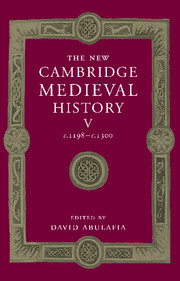Book contents
- Frontmatter
- Introduction
- Part I Common Themes
- Part II The Church in the Thirteenth Century
- Part III The Western Kingdoms
- Part IV Italy
- Part V The Mediterranean Frontiers
- 17 Byzantium after the Fourth Crusade
- 18 The crusades
- 19 Islam and the Mediterranean
- (a) The rise of the Mamluks
- (b) The Maghrib
- (c) The Nasrid kingdom of Granada
- 20 The rise of Aragon-Catalonia
- 21 Castile, Portugal and Navarre
- Part VI The Northern and Eastern Frontiers
- Appendix Genealogical tables
- Primary sources and secondary works arranged by chapter
- Index
- Plate section
- Map 1 Europe in the thirteenth century
- Map 3 France, c. 1260
- Map 5 Germany and the western empire
- Map 6 Genoa, Venice and the Mediterranean
- Map 8 The Latin empire of Constantinople and its neighbours
- Map 10 Aragon and Anjouin the Mediterranean">
- References
(a) - The rise of the Mamluks
from 19 - Islam and the Mediterranean
Published online by Cambridge University Press: 28 March 2008
- Frontmatter
- Introduction
- Part I Common Themes
- Part II The Church in the Thirteenth Century
- Part III The Western Kingdoms
- Part IV Italy
- Part V The Mediterranean Frontiers
- 17 Byzantium after the Fourth Crusade
- 18 The crusades
- 19 Islam and the Mediterranean
- (a) The rise of the Mamluks
- (b) The Maghrib
- (c) The Nasrid kingdom of Granada
- 20 The rise of Aragon-Catalonia
- 21 Castile, Portugal and Navarre
- Part VI The Northern and Eastern Frontiers
- Appendix Genealogical tables
- Primary sources and secondary works arranged by chapter
- Index
- Plate section
- Map 1 Europe in the thirteenth century
- Map 3 France, c. 1260
- Map 5 Germany and the western empire
- Map 6 Genoa, Venice and the Mediterranean
- Map 8 The Latin empire of Constantinople and its neighbours
- Map 10 Aragon and Anjouin the Mediterranean">
- References
Summary
IN Egypt, the thirteenth century of the Christian era began inauspiciously. The country’s agricultural prosperity was dependent on the Nile and its annual flooding, which normally reached its peak in September or October. In 1200, however, where was no such inundation in the autumn. Within weeks of the failure of the Nile, the prices of all foodstuffs climbed steeply. In the months that followed, if the chroniclers are to be believed, whole villages were depopulated, cannibalism became widespread and things came to such a pass that doctors were afraid to make house calls for fear lest they be eaten by the families of their patients. It was also a turbulent year politically, for in January 1200 Saladin’s brother, Sayf ad-Din al-Adil, supported by a regiment of Mamluks (or slave soldiers) formerly in the service of Saladin, removed Saladin’s grandson, al-Mansur Muhammad, from the throne of Egypt and al-Adil declared himself sultan in the boy’s place. By then, Saladin, the founder of the Ayyubid empire in Egypt and Syria, had been dead for seven years. Even during Saladin’s lifetime, his empire had been run as a family business, with his kinsmen controlling large, semi-independent principalities, only loosely responsive to the sultan’s authority. After Saladin’s death those kinsmen, based in Cairo, Damascus and Aleppo, fought amongst themselves for supremacy in Egypt and Syria. They were supported in their struggles by small armies composed of freeborn Kurds and Turks, as well as Turkish Mamluks. At times, indeed, the clansmen and Mamluks dictated the actions of the Ayyubid princelings who were their nominal masters.
- Type
- Chapter
- Information
- The New Cambridge Medieval History , pp. 607 - 621Publisher: Cambridge University PressPrint publication year: 1999
References
- 3
- Cited by

